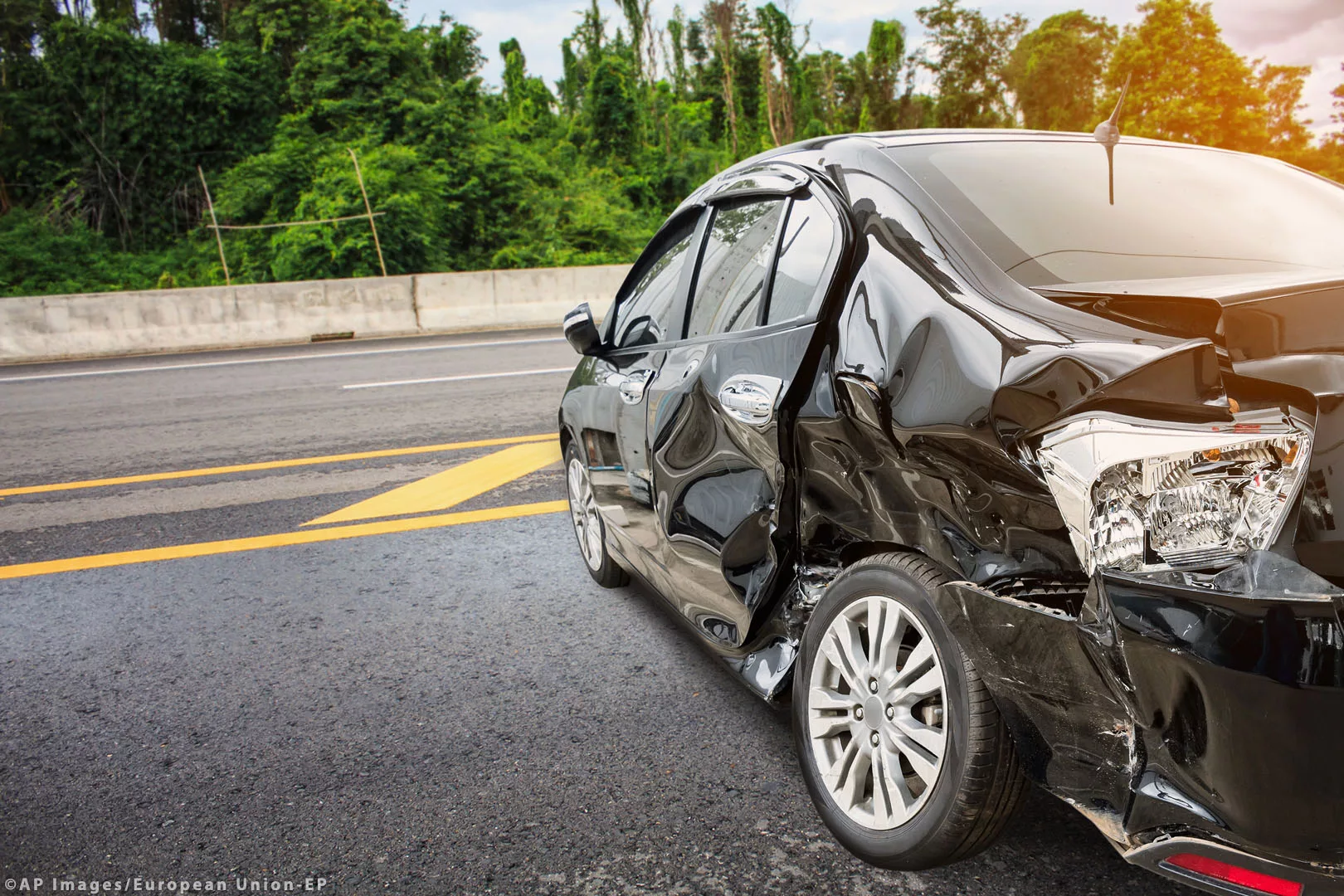
car crash accident on the road
sulieman benn lost his last son in a critical car accident at …
- Concussion in Motor Vehicle Accidents: The Concussion Identification Index
2016-08-03
Motor Vehicle Accidents; TBI (Traumatic Brain Injury); Brain Contusion; Brain Injuries; Cortical Contusion; Concussion Mild; Cerebral Concussion; Brain Concussion; Accidents, Traffic; Traffic Accidents; Traumatic Brain Injury With Brief Loss of Consciousness; Traumatic Brain Injury With no Loss of Consciousness; Traumatic Brain Injury With Loss of Consciousness
- Traffic collisions between electric mobility devices (wheelchairs) and motor vehicles: Accidents, hubris, or self-destructive behavior?
LaBan, Myron M; Nabity, Thomas S
2010-07-01
This study had its genesis in a personally observed collision between a motor vehicle and a motorized wheelchair (electric mobility device) on a busy street in the middle of the block at an unmarked crossing. To the observer, at the time, this appeared to be a suicidal act. This investigation was initiated to both delineate the number of these crashes nationally and understand this phenomena as a potentially planned act of self-destruction. An initial survey of police reports was immediately frustrated by an inability to separate motor vehicle and electric mobility device collisions from the much larger group that involved ambulatory citizens because both types were classified together as “pedestrian” accidents. Instead, the search engine NexisLexis was used to identify 107 newspaper articles each of which described a motor vehicle and electric mobility device accident. In the motor vehicle and electric mobility device collisions, men predominated women (3:1 ratio) with an average age of 56 yrs. Sixty of these accidents were fatal. Ninety-four percent involved an electric mobility device and 6% a manual wheelchair. In 50% of the cases, the motor vehicle was a truck, van, or sport utility vehicle. Fifty percent occurred at dusk or dawn or at night. The electric mobility device occupant was cited as the guilty party in 39% of the cases and the driver of the motor vehicle in 27%. Twenty percent were unwitnessed hit-and-run accidents, whereas “no fault” was found in 8% of the cases. Although many accidents do happen by chance, when an electric mobility device operator openly challenges busy traffic by attempting to traverse it in the middle of the block at an unmarked crossing, predisposing psychosocial factors must also be considered. Hubris or premeditated self-destructive behavior or both need to be explored as preeminent issues with reference to the prodromal of the “accident process.”
- Sleep Apnea Related Risk of Motor Vehicle Accidents is Reduced by Continuous Positive Airway Pressure: Swedish Traffic Accident Registry Data
Karimi, Mahssa; Hedner, Jan; Häbel, Henrike; Nerman, Olle; Grote, Ludger
2015-01-01
Study Objectives: Obstructive sleep apnea (OSA) is associated with an increased risk of motor vehicle accidents (MVAs). The rate of MVAs in patients suspected of having OSA was determined and the effect of continuous positive airway pressure (CPAP) was investigated. Design: MVA rate in patients referred for OSA was compared to the rate in the general population using data from the Swedish Traffic Accident Registry (STRADA), stratified for age and calendar year. The risk factors for MVAs, using demographic and polygraphy data, and MVA rate before and after CPAP were evaluated in the patient group. Setting: Clinical sleep laboratory and population based control (n = 635,786). Patients: There were 1,478 patients, male sex 70.4%, mean age 53.6 (12.8) y. Interventions: CPAP. Measurements and Results: The number of accidents (n = 74) among patients was compared with the expected number (n = 30) from a control population (STRADA). An increased MVA risk ratio of 2.45 was found among patients compared with controls (P accident risk was most prominent in the elderly patients (65–80 y, seven versus two MVAs). In patients, driving distance (km/y), EDS (Epworth Sleepiness score ≥ 16), short habitual sleep time (≤ 5 h/night), and use of hypnotics were associated with increased MVA risk (odds ratios 1.2, 2.1, 2.7 and 2.1, all P ≤ 0.03). CPAP use ≥ 4 h/night was associated with a reduction of MVA incidence (7.6 to 2.5 accidents/1,000 drivers/y). Conclusions: The motor vehicle accident risk in this large cohort of unselected patients with obstructive sleep apnea suggests a need for accurate tools to identify individuals at risk. Sleep apnea severity (e.g., apnea-hypopnea index) failed to identify patients at risk. Citation: Karimi M, Hedner J, Häbel H, Nerman O, Grote L. Sleep apnea related risk of motor vehicle accidents is reduced by continuous positive airway pressure: Swedish traffic accident registry data. SLEEP 2015;38(3):341–349. PMID:25325460
- 2008 South Dakota motor vehicle traffic crash summary
2009-06-01
The Motor Vehicle Traffic Crash Summary is divided into two main sections, Historical : Trends and 2008 Motor Vehicle Traffic Crash Profile. The Historical Trend section : provides information on alcohol involvement in motor vehicle crashes, severity…
- 2009 South Dakota motor vehicle traffic crash summary
2010-06-01
The Motor Vehicle Traffic Crash Summary is divided into two main sections, Historical : Trends and 2009 Motor Vehicle Traffic Crash Profile. The Historical Trend section : provides information on alcohol involvement in motor vehicle crashes, severity…
- 32 CFR 634.28 – Traffic accident investigation.
2010-07-01
… 32 National Defense 4 2010-07-01 2010-07-01 true Traffic accident investigation. 634.28 Section… ENFORCEMENT AND CRIMINAL INVESTIGATIONS MOTOR VEHICLE TRAFFIC SUPERVISION Traffic Supervision § 634.28 Traffic accident investigation. Installation law enforcement personnel must make detailed investigations of…
- 2010 South Dakota motor vehicle traffic crash summary
2011-01-01
The Motor Vehicle Traffic Crash Summary is divided into two main sections, Historical Trends and 2010 Motor Vehicle Traffic Crash Profile. The Historical Trend section provides information on alcohol involvement in motor vehicle crashes, severity of …
- 32 CFR 636.12 – Traffic accident investigation.
2010-07-01
… 32 National Defense 4 2010-07-01 2010-07-01 true Traffic accident investigation. 636.12 Section… ENFORCEMENT AND CRIMINAL INVESTIGATIONS MOTOR VEHICLE TRAFFIC SUPERVISION (SPECIFIC INSTALLATIONS) Fort Stewart, Georgia § 636.12 Traffic accident investigation. In addition to the requirements in § 634.28 of…
- Do alcohol excise taxes affect traffic accidents? Evidence from Estonia.
Saar, Indrek
2015-01-01
This article examines the association between alcohol excise tax rates and alcohol-related traffic accidents in Estonia. Monthly time series of traffic accidents involving drunken motor vehicle drivers from 1998 through 2013 were regressed on real average alcohol excise tax rates while controlling for changes in economic conditions and the traffic environment. Specifically, regression models with autoregressive integrated moving average (ARIMA) errors were estimated in order to deal with serial correlation in residuals. Counterfactual models were also estimated in order to check the robustness of the results, using the level of non-alcohol-related traffic accidents as a dependent variable. A statistically significant (P traffic accidents was disclosed under alternative model specifications. For instance, the regression model with ARIMA (0, 1, 1)(0, 1, 1) errors revealed that a 1-unit increase in the tax rate is associated with a 1.6% decrease in the level of accidents per 100,000 population involving drunk motor vehicle drivers. No similar association was found in the cases of counterfactual models for non-alcohol-related traffic accidents. This article indicates that the level of alcohol-related traffic accidents in Estonia has been affected by changes in real average alcohol excise taxes during the period 1998-2013. Therefore, in addition to other measures, the use of alcohol taxation is warranted as a policy instrument in tackling alcohol-related traffic accidents.
- The Physics of Traffic Accidents
Knight, Peter
1975-01-01
Shows how physics can be used to analyze and prevent traffic accidents by determining critical speeds on curves, the behavior of motor cycles and stability of articulated vehicles, and the visibility that is needed to make a minor road junction safe. (MLH)
- Frequency, causes and human impact of motor vehicle-related road traffic accident (RTA) in Lubumbashi, Democratic Republic of Congo.
Nangana, Luzitu Severin; Monga, Ben; Ngatu, Nlandu Roger; Mbelambela, Etongola Papy; Mbutshu, Lukuke Hendrick; Malonga, Kaj Francoise
2016-09-01
Road traffic accident (RTA)-related trauma remains a public health issue. The aim of this study was to determine the frequency, causes and human impact of motor vehicle-related RTA in Lubumbashi, Democratic Republic of Congo. A prospective cross-sectional study was conducted in the first semester of the year 2015 in which 288 drivers (144 RTA-causing drivers and 144 control drivers who have been declared not guilty by road safety agents) involved in 144 motor vehicle-related RTA were interviewed, and only data on all RTA involving two motor vehicles with at least four wheels were recorded and analyzed. Results showed a total of 144 RTA that involved two motor vehicles with four wheels occurring during the study period which affected 104 people, including 93 injury and 11 fatality cases. The mean age of RTA-causing drivers was 33.8 ± 7.4, whereas it was 35 ± 8.8 for control drivers. The majority of RTA-causing drivers (53.4 %) did not attend a driving school. Over speeding (32 %), distracted driving (22 %), overtaking (16 %) and careless driving/risky maneuver (15 %) and driving under the influence of alcohol (9 %) were the main causes of RTA occurrence. In addition, the absence of a valid driving license [aOR = 12.74 (±2.71); 95 % CI 3.877-41.916; p = 0.015], unfastened seat belt for the RTA-causing driver [aOR = 1.85 (±0.62); 95 % CI 1.306-6.661; p = 0.048] and presence of damages on RTA-causing vehicle [aOR = 33.56 (24.01); 95 % CI 1.429-78.352; p = 0.029] were associated with the occurrence of RTA-related fatality. This study showed a relatively high frequency of RTA occurring in Lubumbashi and suggests the necessity to reinforce road traffic regulation.
- Accidents involving off-road motor vehicles in a northern community.
Hasselback, P; Wilding, H R
1987-01-01
The increasing number of accidents associated with off-road motor vehicles used for recreational purposes prompted this prospective study. During 1985 the records of victims of all motor vehicle accidents who were seen at the Hudson Bay Union Hospital, Hudson Bay, Sask., were studied; patients involved in on-road vehicle accidents were included for comparison. Emphasis was placed on age, vehicle type, mechanism of accident, injury severity and the use of safety features. Almost half of the victims of off-road vehicle accidents were under 16 years of age. The poor adherence to government legislation and manufacturer recommendations was evident in the number of people who did not wear helmets or use headlights. PMID:3651929
- Risk of Motor Vehicle Accidents Related to Sleepiness at the Wheel: A Systematic Review and Meta-Analysis.
Bioulac, Stéphanie; Franchi, Jean-Arthur Micoulaud; Arnaud, Mickael; Sagaspe, Patricia; Moore, Nicholas; Salvo, Francesco; Philip, Pierre
2017-10-01
Sleepiness at the wheel is widely believed to be a cause of motor vehicle accidents. Nevertheless, a systematic review of studies investigating this relationship has not yet been published. The objective of this study was to quantify the relationship between sleepiness at the wheel and motor vehicle accidents. A systematic review was performed using Medline, Scopus, and ISI Web of Science. The outcome measure of interest was motor vehicle accident defined as involving four- or two-wheeled vehicles in road traffic, professional and nonprofessional drivers, with or without objective consequences. The exposure was sleepiness at the wheel defined as self-reported sleepiness at the wheel. Studies were included if they provided adjusted risk estimates of motor vehicle accidents related to sleepiness at the wheel. Risk estimates and 95% confidence intervals (95% CIs) were extracted and pooled as odds ratios (ORs) using a random-effect model. Heterogeneity was quantified using Q statistics and the I2 index. The potential causes of heterogeneity were investigated using meta-regressions. Ten cross-sectional studies (51,520 participants), six case-control studies (4904 participants), and one cohort study (13,674 participants) were included. Sleepiness at the wheel was associated with an increased risk of motor vehicle accidents (pooled OR 2.51 [95% CI 1.87; 3.39]). A significant heterogeneity was found between the individual risk estimates (Q = 93.21; I2 = 83%). Sleepiness at the wheel increases the risk of motor vehicle accidents and should be considered when investigating fitness to drive. Further studies are required to explore the nature of this relationship. PROSPERO 2015 CRD42015024805. © Sleep Research Society 2017. Published by Oxford University Press on behalf of the Sleep Research Society. All rights reserved. For permissions, please e-mail journals.permissions@oup.com.
- Road rage and road traffic accidents among commercial vehicle drivers in Lahore, Pakistan.
Shaikh, M A; Shaikh, I A; Siddiqui, Z
2012-04-01
Road rage and road traffic accidents increase the burden of morbidity and mortality in a population. A cross-sectional survey with convenience sampling was conducted among commercial vehicle drivers in Lahore, Pakistan (n = 901) to record their behaviours/experiences regarding road rage and road traffic accidents. Respondents were asked about incidents of shouting/cursing/rude gestures or threats to physically hurt the person/vehicle, by others or themselves, in the previous 24 hours or 3 months, and their involvement in road traffic accidents in the previous 12 months. Auto-rickshaw drivers were significantly more likely to report various road rage experiences/behaviours and involvement in accidents compared with bus and wagon drivers. A total of 112 respondents (12.4%) reported being involved in a road traffic accident in the previous 12 months but traffic police did not record the accident in 52.7% of cases. The results of this study underline the need to improve road safety in Pakistan.
- Man, road and vehicle: risk factors associated with the severity of traffic accidents.
Almeida, Rosa LÃvia Freitas de; Bezerra Filho, José Gomes; Braga, José Ueleres; Magalhães, Francismeire Brasileiro; Macedo, Marinila Calderaro Munguba; Silva, Kellyanne Abreu
2013-08-01
To describe the main characteristics of victims, roads and vehicles involved in traffic accidents and the risk factors involved in accidents resulting in death. METHODS A non-concurrent cohort study of traffic accidents in Fortaleza, CE, Northeastern Brazil, in the period from January 2004 to December 2008. Data from the Fortaleza Traffic Accidents Information System, the Mortality Information System, the Hospital Information System and the State Traffic Department Driving Licenses and Vehicle database. Deterministic and probabilistic relationship techniques were used to integrate the databases. First, descriptive analysis of data relating to people, roads, vehicles and weather was carried out. In the investigation of risk factors for death by traffic accident, generalized linear models were used. The fit of the model was verified by likelihood ratio and ROC analysis. RESULTS There were 118,830 accidents recorded in the period. The most common types of accidents were crashes/collisions (78.1%), running over pedestrians (11.9%), colliding with a fixed obstacle (3.9%), and with motorcycles (18.1%). Deaths occurred in 1.4% of accidents. The factors that were independently associated with death by traffic accident in the final model were bicycles (OR = 21.2, 95%CI 16.1;27.8), running over pedestrians OR = 5.9 (95%CI 3.7;9.2), collision with a fixed obstacle (OR = 5.7, 95%CI 3.1;10.5) and accidents involving motorcyclists (OR = 3.5, 95%CI 2.6;4.6). The main contributing factors were a single person being involved (OR = 6.6, 95%CI 4.1;10.73), presence of unskilled drivers (OR = 4.1, 95%CI 2.9;5.5) a single vehicle (OR = 3.9, 95%CI 2,3;6,4), male (OR = 2.5, 95%CI 1.9;3.3), traffic on roads under federal jurisdiction (OR = 2.4, 95%CI 1.8;3.7), early morning hours (OR = 2.4, 95%CI 1.8;3.0), and Sundays (OR = 1.7, 95%CI 1.3;2.2), adjusted according to the log-binomial model. CONCLUSIONS Activities promoting the prevention of traffic accidents should primarily focus on
- Undiagnosed post-traumatic stress disorder following motor vehicle accidents.
Green, M M; McFarlane, A C; Hunter, C E; Griggs, W M
1993-10-18
To determine the pattern of emergence of post-traumatic stress disorder (PTSD) among motor vehicle accident victims and to examine the influence of PTSD on subsequent levels of disability. A longitudinal study of motor vehicle accident victims one month and 18 months after the accident. Twenty-four motor vehicle accident victims admitted by the trauma team at the Royal Adelaide Hospital. A 52% response rate was achieved. Post-traumatic stress disorder as diagnosed by the Diagnostic Interview Schedule and disability as measured with the Sickness Impact Profile. Eighteen months after their accidents, six of the 24 subjects had clinically significant PTSD and one was considered borderline. None had been previously diagnosed or treated. The group with PTSD had higher scores on all measures of psychological distress one month after the accident and were more likely to use immature psychological defences. There was no association between physical outcome (measured with the modified Glasgow Outcome Scale) at six months and subsequent diagnosis of PTSD. However, the group with PTSD had higher levels of disability on assessment with the Sickness Impact Profile, particularly in the domain of social functioning. The results suggest PTSD was associated with work-related dysfunction equal to that associated with severe physical handicap. The data from this pilot study suggest that PTSD after motor vehicle accidents is an important cause of disability, which may also become the focus for damages in litigation. Thus, there is a need for further investigation of the early patterns of distress and to design preventive programs for victims of road accidents.
- [Mortality in traffic accidents in Bayamo, Cuba 2011].
Piña-Tornés, Arlines; González-Longoria, Lourdes; González-Pardo, Secundino; Acosta-González, Ariel; Vintimilla-Burgos, Patricio; Paspuel-Yar, Silvana
2014-01-01
With the objective of describing mortality from traffic accidents in Bayamo, Cuba, in 2011 a review was performed of injured and deceased patients due to traffic accidents, recorded in the Hospital Carlos M. de Céspedes. Of the 1,365 injured patients treated in the emergency room, the predominant groups were individuals aged 25 to 44 years comprising 372 patients (27.3%) and men comprising 1,071 (78.5%). 46 people died, most from the same age group and male. Multiple traumatisms (52.6%) and craniofacial trauma (34.2%) were the predominant injuries. Motor vehicle-pedestrian accidents stood out with a mortality of 26.3%. In conclusion, mortality from traffic accidents predominately occurs in young male adults, whose fatal consequences are due to multiple traumatisms from road accidents.
- Road traffic safety in conjunction with in-vehicle ITS
Directory of Open Access Journals (Sweden)
Darja TOPOLÅ EK
2014-06-01
Full Text Available Interest in Intelligent Transportation Systems comes from the problems caused by traffic congestion, road accidents and air pollution. Traffic congestion continues to grow worldwide as a result of increased motorization, population growth, changes in population density and urbanization. Interest in ITS can also be attributed to reducing road accidents and increasing traffic safety. The most common causes for road accidents are excessive speed, inattentive driving and ignorance of the right-of-way rules. To eliminate these causes, experience, knowledge of traffic regulations and a new car are not enough – vehicle safety systems have to take part as well. Therefore, the European Union issued a directive on the installation of intelligent systems, whose functions are active support during driving, warning the driver in dangerous situations and alerting passengers of the car in case of irregularities in motor function or actions carried out by the driver that may cause danger, such as swerving while falling asleep. These systems help drivers to avoid accidents, and in the event of a collision, an emergency call is automatically made. Furthermore, they can be used to regulate traffic patterns or to reduce engine performance, which would reduce pollution. With these benefits in mind, the EU has indicated to the automotive industry that installation of these new Intelligent Transportation Systems should be mandatory in their new vehicles.
- Sleep apnea-related risk of motor vehicle accidents is reduced by continuous positive airway pressure: Swedish Traffic Accident Registry data.
Karimi, Mahssa; Hedner, Jan; Häbel, Henrike; Nerman, Olle; Grote, Ludger
2015-03-01
Obstructive sleep apnea (OSA) is associated with an increased risk of motor vehicle accidents (MVAs). The rate of MVAs in patients suspected of having OSA was determined and the effect of continuous positive airway pressure (CPAP) was investigated. MVA rate in patients referred for OSA was compared to the rate in the general population using data from the Swedish Traffic Accident Registry (STRADA), stratified for age and calendar year. The risk factors for MVAs, using demographic and polygraphy data, and MVA rate before and after CPAP were evaluated in the patient group. Clinical sleep laboratory and population based control (n = 635,786). There were 1,478 patients, male sex 70.4%, mean age 53.6 (12.8) y. CPAP. The number of accidents (n = 74) among patients was compared with the expected number (n = 30) from a control population (STRADA). An increased MVA risk ratio of 2.45 was found among patients compared with controls (P accident risk was most prominent in the elderly patients (65-80 y, seven versus two MVAs). In patients, driving distance (km/y), EDS (Epworth Sleepiness score ≥ 16), short habitual sleep time (≤5 h/night), and use of hypnotics were associated with increased MVA risk (odds ratios 1.2, 2.1, 2.7 and 2.1, all P ≤ 0.03). CPAP use ≥ 4 h/night was associated with a reduction of MVA incidence (7.6 to 2.5 accidents/1,000 drivers/y). The MVA risk in this large cohort of unselected patients with OSA suggests a need for accurate tools to identify individuals at risk. Sleep apnea severity (e.g., apnea-hypopnea index) failed to identify patients at risk. © 2015 Associated Professional Sleep Societies, LLC.
- Correlates of road traffic accident in cases attending IIR hospital Kanpur
Directory of Open Access Journals (Sweden)
Shibajee Debbarma
2016-03-01
Full Text Available Introduction: Globally, road traffic accidents rank 8th among the leading causes of death. According to WHO data, deaths from road traffic injuries account for around 25% of all deaths from injury.Objective: To study the various correlates of road traffic accident in cases attending LLR Hospital, Kanpur.Materials and Methods: The study was conducted among road traffic accident cases attending Emergency Ward of Lala Lajpat Rai Hospital, Kanpur, Uttar Pradesh during the period of March-September, 2015. Data was recorded in a pre-designed and pre-tested questionnaire and analyzed using SPSS software version 16.0.Results: Out of 609 RTA cases, maximum number (54.19% were in 20-40 years age group. Most of the RTA victims were males (69.95% and majority were literate (90.97%. Maximum number (28.74% of RTA took place between 4.00 p.m-8.00 p.m. Maximum number (36.95% of RTA victims were two-wheeler drivers, followed by two-wheeler riders (26.60%. 16.60% of drivers of motorized vehicles had no driving license. 85.48% of motorized vehicle users were not using any protective gear (helmet, seat belt etc. at the time of accident.Conclusion: Young adults in the economically most productive age group were the commonest victims of RTA. There is need of creating awareness regarding traffic rules among general public and strict enforcement of traffic rules by the concerned authori





